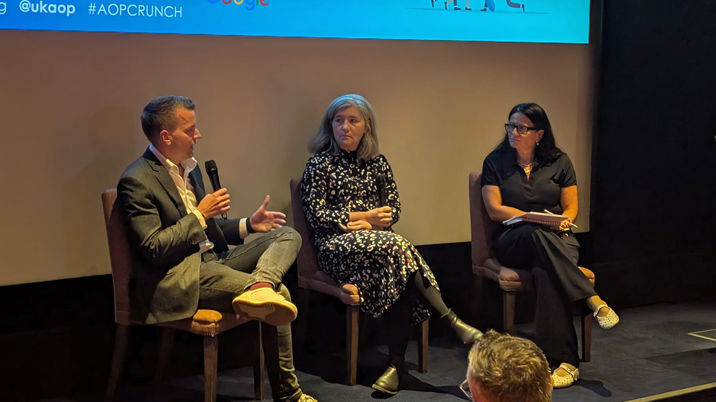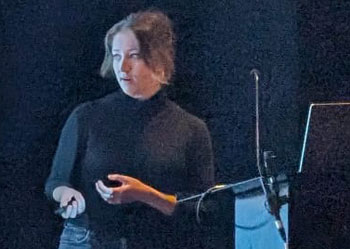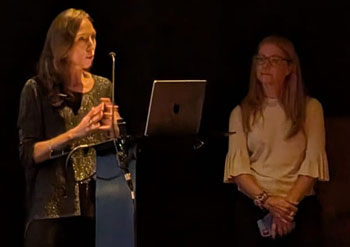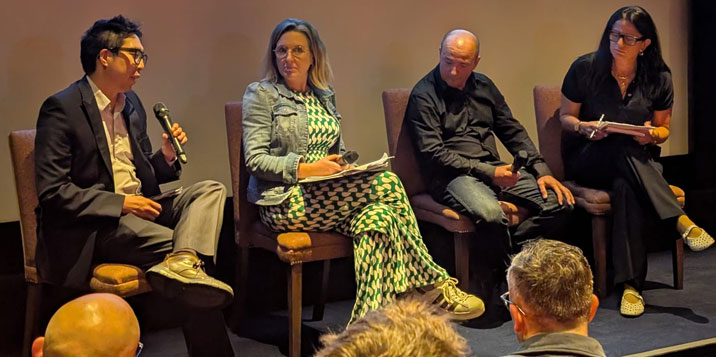
From rage-baiting influencers spreading inflammatory content, to rival states undermining one another with disinformation campaigns, the information superhighway has become clogged by a pile-up of competing narratives. It’s no wonder so many people are deciding to disengage from news entirely.
In a series of presentations and panels moderated by Jules Kendrick, chief growth officer at TAG (the Trustworthy Accountability Group), the latest AOP CRUNCH (on 26th September) invited experts from across the media world to wrestle with how to rebuild trust and reward the organisations that cultivate it at a time when generative AI threatens to further unravel our shared sense of reality.
Navigating AI usage at a time of rising avoidance and mistrust of news

The morning began with a presentation from Nic Newman, senior research associate, Reuters Institute for the Study of Journalism, who shared findings from the institute’s latest Digital News Report. As expected, the survey revealed a strong generational divide in news consumption, with those aged 35+ leaning towards traditional news sites and younger generations favouring social media, while print and TV have declined steeply.
More concerning is the trend towards news avoidance. Since the pandemic, engagement with news has declined and, with it, general trust in news media. Newman partly attributes these trends to the sense of powerlessness that large-scale, tragic world events — such as wars in Ukraine and Middle East — instil in audiences, along with direct attacks on journalists from politicians and fringe media figures. Newman did note, however, that distrust peaks amongst those on the political extremes, while most people want and respect balanced and potentially challenging coverage.
With publishers already walking on eggshells around public trust, it’s vital that they exercise caution in their utilisation of AI. There is a sliding scale of public acceptance of AI use in news, with little concern around efficiency aids such as transcription, summarisation, or transformation — such as text to audio and vice versa. On the other end, there is deep discomfort around AI-generated news stories, photorealistic AI images, and hyper-personalisation — unsurprising when 59% of respondents worry about their ability to tell what is and is not true on the internet in regard to news.
“There’s a lot of different ways [to bolster trust],” said Newman. “In some cases, it’s just showing your workings a bit more. It might be a huge, amazing marketing campaign to explain to people what we do in journalism; verification [of sources] and the importance of facts. That’s what makes us different. Part of the problem has been the sort of flattening on social media. You can’t really tell the difference; you swipe from one thing to the next and they all look the same. Brand values have been lost in that sense, and people’s understanding of them has changed because the media’s changed around them.”
Industry initiatives recognising and rewarding trusted publications
The publishing industry is not resting on its laurels, and CRUNCH welcomed two different industry bodies to share the work they’re doing to support publications committed to trust and transparency — and monetise this reputation in the process.

Chloé Fiodiere from Reporters Without Borders discussed the Journalism Trust Initiative (JTI), where she is deputy director, which aims to recognise and accredit journalistic content amidst the sea of online information. Development of the initiative involved 100 organisations — including, in the UK, The Guardian Foundation, the BBC, and ISO — and includes 130 criteria on transparency and professional practices.
The JTI has since been approved by the European Committee for Standardization and implemented by 1,800 newsrooms across 85 countries and can be used by tech platforms and advertisers to verify the integrity of publications, with LinkedIn integration coming soon. There is currently a pilot programme underway in France where a percentage of advertiser spend is being ringfenced for JTI-approved media. The initiative also supports philanthropic funding and public subsidies for newsrooms that have been vetted for transparency, with a particular focus on journalists covering crisis areas.

Heather Dansie and Niki West from Newsworks — the marketing body for the UK’s national news publishers — discussed the significant trust advantage that such publications have amongst the public, and how this trust can be leveraged to attract advertising revenue.
Newsworks latest trends survey found that 74% of people in the UK turn to news brands to verify stories they encounter on social media and 61% always check for a source. News brands are perceived as being 2.5 times more reliable than social media, with 73% of respondents agreeing on the importance of regulated news providers. The familiarity that the public has with a news brand and the fame it has accrued for quality reporting can boost trust, while low perceived competence and the high consequences of mistakes can drag it down.
High trust news environments deliver a “halo effect” to the brands that advertise on them. In a Newsworks lab test of 5,000 people, there was a 50% uplift in brand trust among those seeing ads on a news website compared to non-news, with an even higher uplift for challenger brands. These findings were corroborated by the latest IPA Data Bank study, which found that advertising campaigns that include print or digital news brands experience a 60% uplift in brand trust.
Engaging with the public to build trust in news media
One of the challenges Charlotte Dewar, CEO, encounters at IPSO — the news regulator — is talking to the public about media literacy in a way that breaks through their day-to-day disinterest in the subject and without coming across as patronising. Dewar has found that, instead of centring “self-regulation” or “editorial standards” in an abstract way, it’s more effective to build the topic into issues they are already passionate about.
“People do care enormously about this, but they care more when it’s about an issue that’s relevant to them... [such as how] survivors of domestic abuse are covered; how journalists can report on evidence given by defendants during court proceedings accurately without framing the story as blaming the victim. Those kinds of issues are massively compelling to people, and that provides a way to talk about these things. Once you’ve got a really interested and engaged audience on an issue, then the public want to see behind the scenes and hear the journalists talk about how hard it was to report that story, or whatever the case may be.”
Owen Meredith, CEO of the News Media Association, sees local journalism as a frontline defence against misinformation. He noted a surge in traffic to local news sites since the pandemic — perhaps driven by people reconnecting with their immediate surroundings — and the perception that local news is less politically partisan than national outlets. This increased engagement in local media has Meredith feeling optimistic about the future of news, and the News Media Association is looking for ways that the government — which is itself undermined by the fragmentation of information — can support such outlets.
“One of the things that we’re challenging UK central government to do is to invest more of their advertising budget with local news media across print and digital, because that’s a really powerful, effective way of communicating to audiences. But, currently, of UK central government advertising spend, only 2% is spent with local news media, versus 16% spent with social platforms. So, if they changed that investment dial and moved from, say, 2% to 5% (not intending to put a target on it) that would make a significant increase in investment going into local newsrooms — ultimately supporting more journalists on the ground to combat some of the mis and disinformation that we’re seeing.”
Publishers on the frontline of the mistrust epidemic
It might be expected that the British Medical Journal (BMJ), with its 184-year heritage, rigorous peer-review process for papers, and strict editorial for its medical professional-focused articles would be insulated from the erosion of trust affecting other publications. While the BMJ’s institutional reputation is strong and its search authority high on Google, health information in general finds itself clashing with public perceptions of medical issues that are often rooted in personal belief. And this only intensified over the pandemic.
“It’s not so much that people don’t trust things,” said Mun-Keat Looi, international features editor, “it’s that increasingly people don’t put faith in things that clash with their perspectives and their beliefs. There is a certain cachet, even, in being labelled as a source of disinformation or misinformation, because it means that you are not ‘the man’, you are not being controlled by big pharma and so on. Not being trusted suddenly means that you are, in a weird way, more trusted in some places. That’s a difficult dynamic to go through, particularly in the health space.”
Generative AI has further complicated the spread of medical misinformation, with scammers using deepfakes of celebrity doctors, such as Hilary Jones, to sell their snake-oil remedies. While studies on this nascent technology are thin on the ground, early research shows that 25—50% of people cannot distinguish a deepfake from a real video.
While AI has been a thorn in the side of health information, it’s been a boon for local journalism. Toby Granville, editorial development director at Newsquest, shared how the local news media group’s team of 20 AI reporters use the technology to produce 4,500 articles a month — primarily content from press releases — freeing up journalists to cover important local news, get out on the street, and produce original journalism that serves their communities. And with Newsquest seeing a 30% subscriber increase in the past year, the strategy seems to be paying off.
Granville believes physical presence is just as important to building trust as technology is: “After Covid, quite a lot of organisations closed their newsrooms. People were working at home or remotely millions of miles away from where their readers were ... At Newsquest, we took the decision not to close any of our local news offices, so the reporters and their editors were — and still are — working in the town centres they’re representing and engaging with. That means they can build relationships; people see them as part of the town or city because they see their offices and their logo. That goes a long way.”
“Fundamentally, I’m an AI optimist,” said Jacqui Merrington, deputy commercial editorial director at Mail Metro Media. “I’m very aware of its limitations, of its risks, of the threats, but I do think that we need to master it and not let it master us.”
For Mail Metro Media, human-generated journalism remains central to trust but the teams are investigating AI’s potential for use in backend operations. “We are exploring different ways that AI is being used in things like personalisation, chatbots, and large document analysis”, says Merrington. “We now have an AI tool that can analyse huge volumes of entities within articles, pulling thousands of people, places, products and brands from articles and analysing the sentiment around them. That can be used to build a whole bunch of products and data strategies.”

Programmatic malaise and values-driven campaigns are bringing brands closer
“The last ten years has been the perfect storm in that consumers have moved to platforms where they have a better, really interesting consumer experience: Facebook, YouTube, etc,” said Dan Larden, head of media at ISBA. “Unfortunately, at the same time, I think the consumer experience got worse [on the open web] ... Ad Tech is arguably not a friend of the premium environment; Ad Tech is set up for scale, for simple metrics, and to make things easier for buyers ...
“Then you consider it from an advertising and agency point of view: how easy it is to use the Facebook platform; how easy it is to include ads and to measure it all; the knowledge that the consumer experience is very good within that ad; and it’s a free platform. Compare this to when you’re trying to buy ads across the ecosystem that you [publishers] represent... You’re represented by DSPs; and DSPs are expensive, not very easy to use, and probably not very aligned with your goals as publishers. Hence, this perfect storm has happened.”
But it’s not all doom and gloom, and there are signs these storm clouds might finally be parting. Larden believes we’re at a tipping point, where frustrations with the programmatic ecosystem (especially now that log-level data is more widely available) and a genuine desire among the buy-side to support premium publishers is leading to closer collaboration between the two ends of the supply chain. What Larden would most like to see is a premium-only marketplace for publishers that possess certain accreditations. Although — as always — the question is, who would pay for it?
Rosie Kitson, chief impact officer at Havas UK&I, is starting to see an attitude shift in the brands Havas represents, where they are realising that premium publishers can share a stronger value alignment than other environments.”
“There’s so much discussion around what content we don’t want to be around. I think we should be talking about what content we do want to be around. What kind of content do we want to be funding?” said Kitson. “All of our clients are investing enormously right now in transforming their business from a sustainability and a social impact perspective. When you invest in something, you’re going to want to see a return on investment, and that’s going to involve marketing.
“These briefs are starting to come through where brands want to talk about what they’re doing from a climate and social perspective, and they also want to be in trusted environments where these topics are talked about. Can we be sponsoring these environments that have real synergy with what our brands are doing?”
If brands can help trusted publications gain a substantial financial foothold over media that spreads fictitious and false narratives — and if the latter can be pushed out of the market through regulation and demonetisation — then there is real hope that the trend of media mistrust can be reversed.












